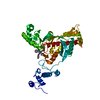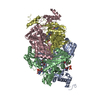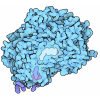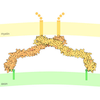[English] 日本語
 Yorodumi
Yorodumi- PDB-8pkn: CryoEM structure of catalytic domain of human HMG-CoA reductase w... -
+ Open data
Open data
- Basic information
Basic information
| Entry | Database: PDB / ID: 8pkn | ||||||||||||||||||||||||||||||
|---|---|---|---|---|---|---|---|---|---|---|---|---|---|---|---|---|---|---|---|---|---|---|---|---|---|---|---|---|---|---|---|
| Title | CryoEM structure of catalytic domain of human HMG-CoA reductase with its inhibitor atorvastatin | ||||||||||||||||||||||||||||||
 Components Components | 3-hydroxy-3-methylglutaryl-coenzyme A reductase | ||||||||||||||||||||||||||||||
 Keywords Keywords | OXIDOREDUCTASE / reductase / cholesterol biosynthesis / lipitor / atorvastatin / statins | ||||||||||||||||||||||||||||||
| Function / homology |  Function and homology information Function and homology informationhydroxymethylglutaryl-CoA reductase (NADPH) / hydroxymethylglutaryl-CoA reductase (NADPH) activity / sterol biosynthetic process / GTPase regulator activity / coenzyme A binding / negative regulation of amyloid-beta clearance / Cholesterol biosynthesis / coenzyme A metabolic process / EGR2 and SOX10-mediated initiation of Schwann cell myelination / isoprenoid biosynthetic process ...hydroxymethylglutaryl-CoA reductase (NADPH) / hydroxymethylglutaryl-CoA reductase (NADPH) activity / sterol biosynthetic process / GTPase regulator activity / coenzyme A binding / negative regulation of amyloid-beta clearance / Cholesterol biosynthesis / coenzyme A metabolic process / EGR2 and SOX10-mediated initiation of Schwann cell myelination / isoprenoid biosynthetic process / peroxisomal membrane / cholesterol biosynthetic process / negative regulation of protein secretion / regulation of ERK1 and ERK2 cascade / NADPH binding / Activation of gene expression by SREBF (SREBP) / PPARA activates gene expression / negative regulation of protein catabolic process / visual learning / long-term synaptic potentiation / endoplasmic reticulum membrane / endoplasmic reticulum Similarity search - Function | ||||||||||||||||||||||||||||||
| Biological species |  Homo sapiens (human) Homo sapiens (human) | ||||||||||||||||||||||||||||||
| Method | ELECTRON MICROSCOPY / single particle reconstruction / cryo EM / Resolution: 2.26 Å | ||||||||||||||||||||||||||||||
 Authors Authors | Manikandan, K. / Van Rooyen, J. | ||||||||||||||||||||||||||||||
| Funding support |  United Kingdom, 1items United Kingdom, 1items
| ||||||||||||||||||||||||||||||
 Citation Citation |  Journal: Acta Crystallogr F Struct Biol Commun / Year: 2025 Journal: Acta Crystallogr F Struct Biol Commun / Year: 2025Title: Cryo-EM structures of apo and atorvastatin-bound human 3-hydroxy-3-methylglutaryl-coenzyme A reductase. Authors: Manikandan Karuppasamy / Jason van Rooyen /  Abstract: The enzyme 3-hydroxy-3-methylglutaryl-coenzyme A reductase (HMGR) regulates the level of cholesterol by catalysing the formation/production of mevalonate and has therefore become an important ...The enzyme 3-hydroxy-3-methylglutaryl-coenzyme A reductase (HMGR) regulates the level of cholesterol by catalysing the formation/production of mevalonate and has therefore become an important pharmaceutical target for coronary heart disease. Here, we report the cryo-EM structure of the catalytic part of the enzyme in the apo form and bound with its inhibitor atorvastatin, a commonly used drug in cardiovascular disease, at resolutions of 2.1 and 2.3 Å, respectively. In the cryo-EM maps, part of the N-domain corresponding to amino acids 439-487 is well ordered and could be modelled completely. Atorvastatin molecules were found to occupy all four active sites of the tetrameric complex, and the binding does not alter the conformation of the protein or the active site. The method described here exploits graphene oxide as an additional support and could be used as an alternative to elucidate the structures of pharmaceutical target compounds that are difficult to co-crystallize with human HMGR and for sparsely available samples in drug discovery. #1:  Journal: Science / Year: 2001 Journal: Science / Year: 2001Title: Structural mechanism for statin inhibition of HMG-CoA reductase. Authors: E S Istvan / J Deisenhofer /  Abstract: HMG-CoA (3-hydroxy-3-methylglutaryl-coenzyme A) reductase (HMGR) catalyzes the committed step in cholesterol biosynthesis. Statins are HMGR inhibitors with inhibition constant values in the nanomolar ...HMG-CoA (3-hydroxy-3-methylglutaryl-coenzyme A) reductase (HMGR) catalyzes the committed step in cholesterol biosynthesis. Statins are HMGR inhibitors with inhibition constant values in the nanomolar range that effectively lower serum cholesterol levels and are widely prescribed in the treatment of hypercholesterolemia. We have determined structures of the catalytic portion of human HMGR complexed with six different statins. The statins occupy a portion of the binding site of HMG-CoA, thus blocking access of this substrate to the active site. Near the carboxyl terminus of HMGR, several catalytically relevant residues are disordered in the enzyme-statin complexes. If these residues were not flexible, they would sterically hinder statin binding. | ||||||||||||||||||||||||||||||
| History |
|
- Structure visualization
Structure visualization
| Structure viewer | Molecule:  Molmil Molmil Jmol/JSmol Jmol/JSmol |
|---|
- Downloads & links
Downloads & links
- Download
Download
| PDBx/mmCIF format |  8pkn.cif.gz 8pkn.cif.gz | 97.2 KB | Display |  PDBx/mmCIF format PDBx/mmCIF format |
|---|---|---|---|---|
| PDB format |  pdb8pkn.ent.gz pdb8pkn.ent.gz | 67.7 KB | Display |  PDB format PDB format |
| PDBx/mmJSON format |  8pkn.json.gz 8pkn.json.gz | Tree view |  PDBx/mmJSON format PDBx/mmJSON format | |
| Others |  Other downloads Other downloads |
-Validation report
| Summary document |  8pkn_validation.pdf.gz 8pkn_validation.pdf.gz | 456.6 KB | Display |  wwPDB validaton report wwPDB validaton report |
|---|---|---|---|---|
| Full document |  8pkn_full_validation.pdf.gz 8pkn_full_validation.pdf.gz | 457.8 KB | Display | |
| Data in XML |  8pkn_validation.xml.gz 8pkn_validation.xml.gz | 9.4 KB | Display | |
| Data in CIF |  8pkn_validation.cif.gz 8pkn_validation.cif.gz | 14.2 KB | Display | |
| Arichive directory |  https://data.pdbj.org/pub/pdb/validation_reports/pk/8pkn https://data.pdbj.org/pub/pdb/validation_reports/pk/8pkn ftp://data.pdbj.org/pub/pdb/validation_reports/pk/8pkn ftp://data.pdbj.org/pub/pdb/validation_reports/pk/8pkn | HTTPS FTP |
-Related structure data
| Related structure data |  17748MC  8s6bC M: map data used to model this data C: citing same article ( |
|---|---|
| Similar structure data | Similarity search - Function & homology  F&H Search F&H Search |
- Links
Links
- Assembly
Assembly
| Deposited unit | 
| ||||||||||||||||||||
|---|---|---|---|---|---|---|---|---|---|---|---|---|---|---|---|---|---|---|---|---|---|
| 1 | 
| ||||||||||||||||||||
| Noncrystallographic symmetry (NCS) | NCS oper:
|
- Components
Components
| #1: Protein | Mass: 45259.016 Da / Num. of mol.: 1 Source method: isolated from a genetically manipulated source Source: (gene. exp.)  Homo sapiens (human) / Gene: HMGCR / Production host: Homo sapiens (human) / Gene: HMGCR / Production host:  References: UniProt: P04035, hydroxymethylglutaryl-CoA reductase (NADPH) |
|---|---|
| #2: Chemical | ChemComp-117 / |
| Has ligand of interest | Y |
| Has protein modification | N |
-Experimental details
-Experiment
| Experiment | Method: ELECTRON MICROSCOPY |
|---|---|
| EM experiment | Aggregation state: PARTICLE / 3D reconstruction method: single particle reconstruction |
- Sample preparation
Sample preparation
| Component | Name: Catalytic part of hHMGCoA reductase / Type: COMPLEX / Entity ID: #1 / Source: RECOMBINANT |
|---|---|
| Molecular weight | Value: 214 kDa/nm / Experimental value: NO |
| Source (natural) | Organism:  Homo sapiens (human) Homo sapiens (human) |
| Source (recombinant) | Organism:  |
| Buffer solution | pH: 7.5 |
| Specimen | Embedding applied: NO / Shadowing applied: NO / Staining applied: NO / Vitrification applied: YES |
| Specimen support | Grid material: COPPER / Grid mesh size: 300 divisions/in. / Grid type: Quantifoil R1.2/1.3 |
| Vitrification | Instrument: FEI VITROBOT MARK IV / Cryogen name: ETHANE |
- Electron microscopy imaging
Electron microscopy imaging
| Experimental equipment |  Model: Titan Krios / Image courtesy: FEI Company |
|---|---|
| Microscopy | Model: TFS KRIOS |
| Electron gun | Electron source:  FIELD EMISSION GUN / Accelerating voltage: 300 kV / Illumination mode: FLOOD BEAM FIELD EMISSION GUN / Accelerating voltage: 300 kV / Illumination mode: FLOOD BEAM |
| Electron lens | Mode: BRIGHT FIELD / Nominal magnification: 105000 X / Nominal defocus max: 2000 nm / Nominal defocus min: 800 nm / Cs: 2.7 mm / C2 aperture diameter: 50 µm / Alignment procedure: COMA FREE |
| Specimen holder | Cryogen: NITROGEN / Specimen holder model: FEI TITAN KRIOS AUTOGRID HOLDER |
| Image recording | Electron dose: 42 e/Å2 / Film or detector model: GATAN K3 (6k x 4k) / Num. of grids imaged: 1 / Num. of real images: 18337 |
- Processing
Processing
| EM software |
| ||||||||||||||||||||||||||||||||||||||||||||||||||||||||||||||||||||||||||||||||||||||||||||||||||||||||||
|---|---|---|---|---|---|---|---|---|---|---|---|---|---|---|---|---|---|---|---|---|---|---|---|---|---|---|---|---|---|---|---|---|---|---|---|---|---|---|---|---|---|---|---|---|---|---|---|---|---|---|---|---|---|---|---|---|---|---|---|---|---|---|---|---|---|---|---|---|---|---|---|---|---|---|---|---|---|---|---|---|---|---|---|---|---|---|---|---|---|---|---|---|---|---|---|---|---|---|---|---|---|---|---|---|---|---|---|
| CTF correction | Type: PHASE FLIPPING AND AMPLITUDE CORRECTION | ||||||||||||||||||||||||||||||||||||||||||||||||||||||||||||||||||||||||||||||||||||||||||||||||||||||||||
| Particle selection | Num. of particles selected: 3061130 | ||||||||||||||||||||||||||||||||||||||||||||||||||||||||||||||||||||||||||||||||||||||||||||||||||||||||||
| Symmetry | Point symmetry: D2 (2x2 fold dihedral) | ||||||||||||||||||||||||||||||||||||||||||||||||||||||||||||||||||||||||||||||||||||||||||||||||||||||||||
| 3D reconstruction | Resolution: 2.26 Å / Resolution method: FSC 0.143 CUT-OFF / Num. of particles: 404712 / Algorithm: BACK PROJECTION / Symmetry type: POINT | ||||||||||||||||||||||||||||||||||||||||||||||||||||||||||||||||||||||||||||||||||||||||||||||||||||||||||
| Atomic model building | Protocol: RIGID BODY FIT / Space: REAL | ||||||||||||||||||||||||||||||||||||||||||||||||||||||||||||||||||||||||||||||||||||||||||||||||||||||||||
| Atomic model building | PDB-ID: 1hwk Accession code: 1hwk / Source name: PDB / Type: experimental model | ||||||||||||||||||||||||||||||||||||||||||||||||||||||||||||||||||||||||||||||||||||||||||||||||||||||||||
| Refinement | Resolution: 2.26→147.74 Å / Cor.coef. Fo:Fc: 0.932 / WRfactor Rwork: 0.316 / SU B: 3.345 / SU ML: 0.079 / Average fsc free: 0 / Average fsc overall: 0.8673 / Average fsc work: 0.8673 / ESU R: 0.082 Details: Hydrogens have been added in their riding positions
| ||||||||||||||||||||||||||||||||||||||||||||||||||||||||||||||||||||||||||||||||||||||||||||||||||||||||||
| Solvent computation | Solvent model: NONE | ||||||||||||||||||||||||||||||||||||||||||||||||||||||||||||||||||||||||||||||||||||||||||||||||||||||||||
| Displacement parameters | Biso mean: 81.224 Å2 | ||||||||||||||||||||||||||||||||||||||||||||||||||||||||||||||||||||||||||||||||||||||||||||||||||||||||||
| Refine LS restraints |
|
 Movie
Movie Controller
Controller




 PDBj
PDBj


